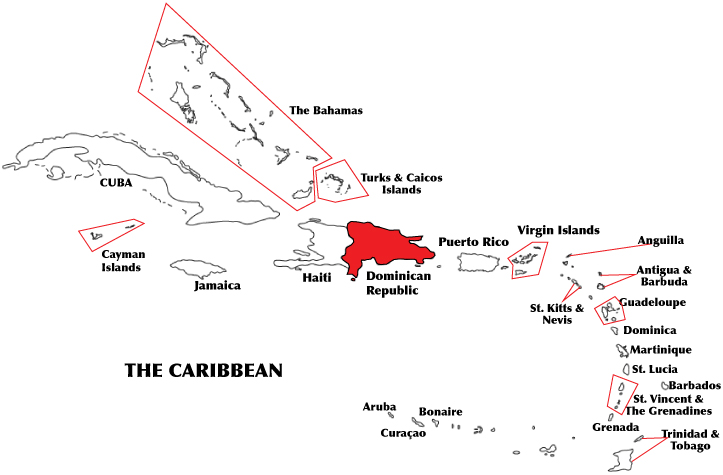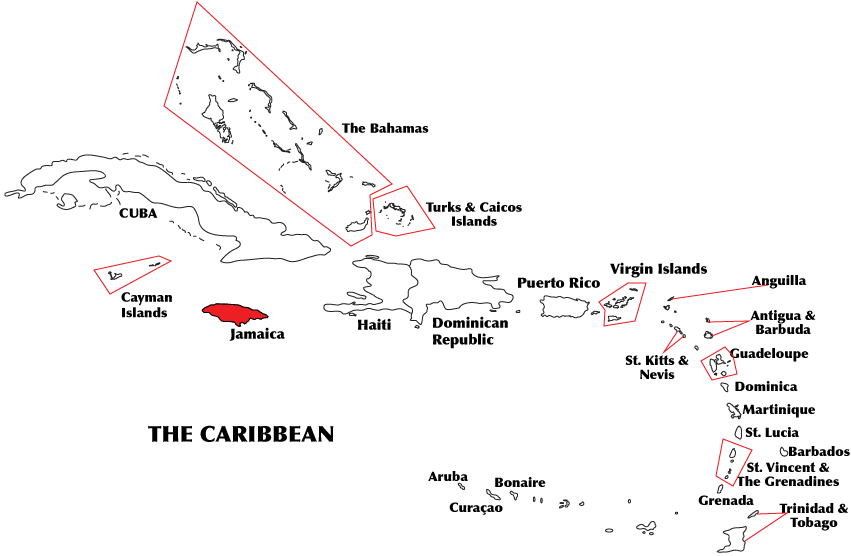[My study summary and IQ estimate for Guadeloupe are withdrawn until I can get some necessary clarifications about the control group from the study authors (Massina et al, 2000). H/T to a reader from Martinique.]
Category: Caribbean (Page 1 of 2)

The Turks and Caicos Islands is classified as a British Overseas Territory (other examples are Bermuda and the Cayman Islands). It has a population of 32,000, and its demographics are 88% black and 8% white. Like many small Caribbean territories, the Turks and Caicos Islands enjoy a high standard of living fueled by finance and tourism.
Lynn & Vanhanen do not have a study for this territory and, with the exception of Bermuda, they don’t include British Overseas Territories in their full dataset of estimated scores.
In this short post I summarize one study for the Turks and Caicos Islands.
Continue reading

The American Virgin Islands are a territorial possession of the United States. According to the 2010 census, it has a population of 106,405 and an ethnic composition that is 76% black and 15.6% white. Almost all of the inhabitants live on three main islands: St. Croix, St. John, and St. Thomas. Virgin Islanders, much like Puerto Ricans, are United States citizens, but there has not been a similar push for U.S. statehood in this small territory.
Here I discuss several studies that have looked at the intelligence and academic skills of Virgin Islanders.
Continue reading

The Commonwealth of Puerto Rico is a Spanish-speaking territory of the United States. Puerto Ricans are United States citizens—they can freely migrate between the island and the states, join the military, or even run for president. But they can’t vote for president, because the territory is not a U.S. state. In three referendums from 1967 to 1998, Puerto Rican voters rejected both political independence and U.S. statehood. However, in November 2012 a solid majority (61.3%) voted in favor of statehood. This kind of political nudging could quite possibly result in Puerto Rico becoming the 51st U.S. state … but only Congress and the president have authority over the matter, and analysts agree that approval is unlikely. This particular referendum also left off the option traditionally most favored by Puerto Ricans: continued commonwealth status. Many islanders appear to feel that statehood offers few additional benefits over citizenship; a majority of Puerto Ricans already live on the U.S. mainland (5 million vs. 3.7 million).
From the earliest days of intelligence testing, social scientists have taken a special interest in U.S. Hispanics. Proportionate to their numbers, it’s possible that more tests have been given to Hispanics than to blacks. But this special attention has also lacked focus. African-American test results have been subject to meticulous cataloging, synthesis and analysis (Shuey, 1966; Jensen, 1998; Jencks & Phillips, 1998) leading to somewhat of a consensus on the size and shape of the black-white cognitive performance gap. Yet there has not been a similar effort to process the disparate and voluminous literature on the abilities of U.S. Hispanics. Therefore there is less knowledge and consensus about the historical and contemporary test performance of Hispanic minorities.
Most of the U.S. Hispanic population is Mexican American (63%). Puerto Ricans are the second largest Hispanic minority (9.2% … or 15.3% including the Commonwealth). This post represents the first effort to comprehensively summarize the abilities of one of these two important American minority groups. Here I describe and analyze the results from over 70 studies that have measured the abilities of Puerto Ricans.

Bermuda is a tiny British Overseas Territory in the North Atlantic Ocean, some 600 miles from the East Coast of the United States (population: 64,700). Even though Bermuda is 1000 miles from the Caribbean Sea, there are a number of sociological similarities between Bermuda and the Caribbean island nations; it is an associate member of the Caribbean Community. Its economy, much like the Cayman Islands and The Bahamas, is largely based on finance and tourism, and it likewise enjoys one of the highest standards of living in the world.
According to the 2000 census, Bermuda is 54.8% black and 34.1% white. IQ and the Wealth of Nations (2002) did not include intelligence data for Bermuda, but IQ and Global Inequality (2006) reported an IQ of 90, as the average of two studies. In this post I discuss some overlooked data which suggest that Bermudian blacks have an IQ that is very close to 100, and that there is no IQ gap between black and white Bermudians. There is also some overlooked test data which suggest otherwise, and we are left with some uncertainty over the meaning of the conflicting research. Continue reading

The Dominican Republic shares the island of Hispaniola with Haiti, but has a much higher standard of living. Jared Diamond offered some characteristically plausible-sounding reasons for this disparity in his 2005 book Collapse, and these ideas received a fair bit of media coverage following the Haiti earthquake in 2010. While race and human capital both played a part in those explanations, Diamond did not mention intelligence differences (having already rejected this line of thinking as “loathsome” in Guns, Germs, and Steel (1997)). However, the theoretical relevance of this variable is obvious: intelligence and achievement tests are a more direct measure of individual human capital than input variables like education. Jones and Schneider (2006) found IQ to be “the most robust human capital measure” in an expansive dataset of international comparison measures—a better predictor of economic development than variables like educational spending and enrollment.
IQ and the Wealth of Nations (2002) did not include data for either Haiti or the Dominican Republic, but Lynn’s dataset has included one study for the Dominican Republic since the publication of IQ and Global Inequality (2006).
Here I scrutinize Lynn’s use of this reference and introduce a few more small studies. The data available for the Dominican Republic is quite meager. Continue reading

The Bahamas is one of the most prosperous nations in the world (Third highest GDP per capita in the Americas, behind the US and Canada), with an economy, much like the Cayman Islands, primarily dependent upon tourism and finance. The population, not much larger than 350,000, is 85% black, 12% white, and 3% Asian and Latin American.
IQ and the Wealth of Nations (2002) does not have a study for The Bahamas, but estimates an IQ of 78 by using the score from Barbados (p. 74). IQ and Global Inequality (2006) estimates an IQ of 84 by averaging the scores from Cuba and the Dominican Republic (p. 55), and this is the estimate still reported in the most recent book (Lynn & Vanhanen, 2012, p. 20).
Here I discuss measured IQ data for The Bahamas from two different studies. Continue reading

IQ and the Wealth of Nations (2002) cites one study for Jamaica (Manley, 1963 ![]() ). The sample size is nearly two thousand school children, and the reported IQ is 72 (p. 209). Lynn’s various updates to that book have included five additional references. However, in another anomaly, the most recent book contains only two references, both with relatively small sample sizes, and omits the large study altogether. The IQ estimate for Jamaica has also been lowered to 67! (Lynn, 2012, p. 403)
). The sample size is nearly two thousand school children, and the reported IQ is 72 (p. 209). Lynn’s various updates to that book have included five additional references. However, in another anomaly, the most recent book contains only two references, both with relatively small sample sizes, and omits the large study altogether. The IQ estimate for Jamaica has also been lowered to 67! (Lynn, 2012, p. 403)
Here I review over 20 intelligence test studies from Jamaica. I find that Lynn’s numbers were not accurately reported, and that IQ is significantly higher in Jamaica than his books have claimed. Continue reading

The Cayman Islands is a British Overseas Territory. In global comparison, this tiny dependency ranks near the top in standard of living and per capita GDP (currently sandwiched between the U.S., Ireland, Japan and Iceland). Lynn and Vanhanen’s books include data for Bermuda—another Overseas Territory—but do not mention the Cayman Islands.
At least one psychologist has administered intelligence tests to Cayman Islands school children (1960 Curti ![]() ), and this forgotten study is noteworthy because it is also one of the relatively rare instances where black and white IQ scores have been compared outside of the United States, Britain, and South Africa. Continue reading
), and this forgotten study is noteworthy because it is also one of the relatively rare instances where black and white IQ scores have been compared outside of the United States, Britain, and South Africa. Continue reading

There are several intelligence studies for Cubans, including at least two Raven standardizations, some international assessment data, and a few different test measures for Cuban Americans. The message of all these test results is complicated and leaves us with a few puzzles.
IQ and the Wealth of Nations (2002) and IQ and Global Inequality (2006) both list one intelligence study for Cuba: a large Standard Progressive Matrices standardization (Alonso Garcia, 1973 ![]() ). In another anomaly, however, this reference has disappeared from the latest version of the dataset (Lynn & Vanhanen, 2012). Cuba is missing from their list of ‘National IQs’ (p. 391), and the reference is not in the bibliography. But this omission is clearly a mistake, since one table (p. 22) still features a ‘Measured IQ’ score for Cuba—85—the same score paired with this study in the previous books. Continue reading
). In another anomaly, however, this reference has disappeared from the latest version of the dataset (Lynn & Vanhanen, 2012). Cuba is missing from their list of ‘National IQs’ (p. 391), and the reference is not in the bibliography. But this omission is clearly a mistake, since one table (p. 22) still features a ‘Measured IQ’ score for Cuba—85—the same score paired with this study in the previous books. Continue reading
